I needed to learn how to silk screen for another project I am working on so I ordered some silkscreening supplies to give this process a shot.
The basic concept of silkcreening is to transfer an image to a screen which is made up of a mesh of 1000’s of tiny strings interwoven with each other. Once the image is transferred you push ink through the screen with a squeegee onto an object below, like a shirt or a mouse pad or something of that sort.
I bought almost all of my supplies from silkscreeningsupplies.com they have a very comprehensive collection of products and they also have a lot of videos on YouTube which demonstrate how to do silk screening in great detail. I’ll be including some of there videos here for example purpose.
I ordered 2 16×20 inch 230 mesh screens in a wooden frames to begin with, this was the smallest size they had available other than a screen made for hats which was just a few dollars cheaper. I’d rather spend a couple bucks more and get 4 times the usable area. The mesh of the screen indicates how many threads-per-inch (TPI) there are. One a 230 mesh screen in each square inch there are 230 thread going left to right, and 230 threads woven in top to bottom. The space in between the weaves is where the ink goes through to the surface below. The higher the thread count, the tighter the mesh and the higher the resolution you can get.
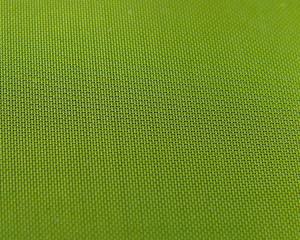
Making silk screens can be done in various ways, the main goal is to block off all of the areas on the screen which you do not want ink to move through. The finished result is called a stencil. To make my stencil I decided to go with the photographic method where a UV light sensitive emulsion is spread over the screen and dried. The emulsions also come in many different flavors. The one I used was a photographic emulsion called WBP from Ryonet/SilkScreeningSupplies.com it is designed to work with water based and Plastisol inks which are commonly used on textiles such as t-shirts and hats, etc. A quart of this costs around $30 dollars, but goes a long way, unfortunately once you’ve mixed in the photographic sensitizer it only has a shelf life of about 30 days. You can also buy pints of emulsion, and this may be the way to go to start, I didn’t realize how far a quart would actually go. Here’s a video from Ryonet showing how to coat a screen in emulsion it’s pretty long but very detailed. If you don’t have the aluminum scoop coater like they use, and I used, you can use cardboard or a squeegee, but the results with their aluminum scoop coater were excellent even on my first tries.
That video was pretty explanatory of the screen coating process. Before you coat you do have to degrease and prep the screen. This is done pretty easily with a screen prep solution you can buy and a handheld scrubber.
You don’t have to use a screen holder like they used when applying the emulsion. I just held the frame in one hand and move the coater over the front surface and then the back surface. It’s pretty easy to make a coating stand with some 2x2s and a plywood base. For my first screens I only did one coat per side, but I probably should have done two coats. Also you’ll notice that the room in the video above is lit in yellow. Because the emulsion is UV sensitive you have to use a UV filtered light. A yellow bug light works, but all I had on hand was a red spiral fluorescent tube. I would recommend the yellow as you get better room lighting and it’s easier to see what you’re doing.
I let my first screen dry in a light safe box and it took about 4 hours until it was not tacky anymore. The second silk screen I made I used a fan to blow over it and it dried in about 2.5 hours. While that was going on I made the artwork I was going to transfer to the screen, just simple text for starters. I drew up the artwork (text) in Photoshop, but you could do this in a free graphics program like GIMP which is similar to Photoshop in functionality. I the printed the artwork on to 4 transparency film sheets. I knew that my laser printer didn’t print transparencies well, so I printed 4 copies so I could tape them over each other to make the template more light resistant. It took a little work to align the sheets, but was not too bad overall. I taped them onto a thin piece of glass from a picture frame. You can see the poor quality of toner and how transparent it is on a single sheet by looking at the picture below and the one below that shows the taped stack.
The photo below shows me exposing the frame. I placed a box on the table with a flat MDF board on top of it smaller than the inside dimensions of the screen. I then set the screen over the board, this holds the screen surface flat as any wrinkles or ripples could adversely affect the exposure and make it come out bad. I then put the piece of glass with my artwork on top the screen. You’ll notice that the artwork/text is backwards but once the screen is done it will print forward and all will be good.
On my first try I used a short wave UVB (315-280nm wavelength) lamp. This is a fluorescent lamp with no coating on it. Normal fluorescent lamps have a white coating on the inside which converts the UV light into white light, and a blacklight bulb has a filter that only lets long wave UVA (400-315nm) through. Using this lamp was a mistake. While glass is partially transparent to UVA (like from a black light) it looks solid to UVB light. When I exposed my template the area around the glass exposed, but the area under the glass, and my template did not! If you want to use UVB exposure, you need to use a quartz glass which is transparent to UVB. You can see the UVB setup below. Please keep in mind that excessive UVB exposure is hazardous and you should not look directly into it. I used a pair of UV Blocking welders glasses when setting it up and did not hang out in the room while the board exposed.
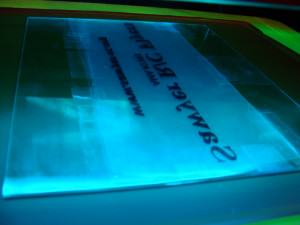 When that failed I switched to another light. I used a 500 Watt halogen light fixture like you get from one of the big box stores. They only cost $15-20 dollars. With my setup with the 500 watt halogen lamp 15 inches from the screen it took about 15 minutes to expose the screen. I think next time I will try closer to 20 minutes as the section under the glass was slightly less cured than the area which was not under the glass, more on how I figured that out in a bit though.
When that failed I switched to another light. I used a 500 Watt halogen light fixture like you get from one of the big box stores. They only cost $15-20 dollars. With my setup with the 500 watt halogen lamp 15 inches from the screen it took about 15 minutes to expose the screen. I think next time I will try closer to 20 minutes as the section under the glass was slightly less cured than the area which was not under the glass, more on how I figured that out in a bit though.
Update: Here are a couple of pictures I took of exposing my third frame (A dragon picture I found on Google) with the 500 watt halogen lamp. You can see the bare frame, then with the artwork put in place and then the spacing of the exposure lamp at 15 inches. I exposed this frame for 25 minutes, but I think I should have stuck with my plan to do 20 minutes instead.
The first screen I did with the 500 Watt halogen turned out way over exposed. I was holding the light by hand and must have gotten it too close to the surface. The second screen I made a simple fixture to hold the lamp 15 inches from the surface of the screen and it worked out fine. You can see the first screen I made below. I could tell already when I pulled it off the exposure table that it wasn’t right, but I took it upstairs and rinsed it out with the bathroom spray nozzle anyways to get a better look at it.
Well that was no fun, you can see a couple of letters washed out, and while I could see the shadow of the rest in the screen, they refused to wash out. I knew this screen was a waste so I went and coated another screen with emulsion and let it dry. I then exposed it again under the 500 watt halogen and had much better results. After the 15 minute exposure I could immediately see the image in the emulsion as seen in the picture below. It’s a bit dark but the only lighting in the room was my red filtered light. I didn’t want to risk using the camera flash and exposing my graphic.
Update: Here’s a picture of the third screen I exposed, the dragon screen. You can see it sitting in the tub ready for rinse and the pattern is very visible and easy to make out. In the picture below I’ve just wetted both sides of the screen and let it soak into the unexposed emulsion a bit, and then started rinsing out.
Back to the second screen for now though. I ran upstairs to the bathtub to rinse out the text screen. The text came out so easily it was wonderful. I did notice that the emulsion which was under the glass had become a bit slimey though. This is an indication that it is underexposed. I continued with the rinse and it wasn’t so bad that the slimy emulsion was filling in the cleared screen area so once it was washed out I dried the area off with a towel and took a couple of photographs showing the end product, at least where the screen production was involved.
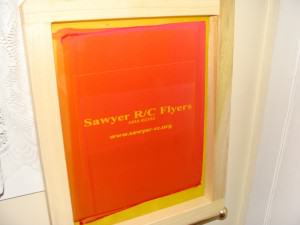 I learned that the sliminess was under-exposure from this video below from Ryonet (at 3:10 in time) but after checking it out I knew it was usable with a little more work.
I learned that the sliminess was under-exposure from this video below from Ryonet (at 3:10 in time) but after checking it out I knew it was usable with a little more work.
You can see clearly in the above photo the underexposed area. Once the screen was dry I put it under an exposure lamp for a few more minutes to make sure the entire blocking area was cured and I double checked the clear area with a bright light to make sure the screen was clear from any obstructions then put things away for the night.
This morning I woke and my first goal was to screen print some shirts. I had purchased an 8 oz bottle of Jacquard Super Opaque White ink from another source. While Ryonet has a lot of options, they didn’t seem to have ink in these tiny quantities, and I didn’t want to invest in pints or quarts of ink for these small initial projects. The 8oz bottle of Jacquard Super Opaque White was about $6 dollars if I remember correctly. I don’t have a fancy screen printing press yet (I need to build something) so for the time being I just lifted the screen off the surface of what I wanted to print, flooded the screen by dragging the squeegee across it, and then set the screen down on the surface I wanted to print and pulled the squeegee firmly over the surface.
The first print I did was onto a piece of black stick backed ‘art foam’. You can see it in the photo below. The ink layer is pretty thin and didn’t fill as well as I had hoped. There are a couple of reasons for this I’m sure. The first is that the ink is very thick, and had I looked before I would have seen that people usually thin out this white ink with a few drops of water (It’s water based, so that’s ok!). Second my screen only had a single layer of emulsion on each side which limits how much ink you can store in the screen. If I had done two layers on each side the screen could hold more ink to transfer to the shirt. That said, I think the foam object turned out ok. It’s a bit rippled because I used a heat gun to cure the ink which is far from producing accurate temperature control.
The second thing I screened with this stencil was on the back of a t-shirt. I have this orange t-shirt that I usually only wear for yard work or when I go flying my R/C planes. Again there didn’t seem to be enough ink deposited onto the shirt, and you can also see where I accidentally set down the frame and then repositioned it. There’s a very light copy of the stencil offset from the main print.
I did another silkscreen, I put a couple of the pictures up above to improve my explanations. I also took some more pictures of the screening proccess which I’ll explain below. I washed out the dragon frame and it turned out alright, a little to over exposed which meant it took a lot more work to clear the image out of the screen area. 20 minutes seems like it will be optimum with this setup and the multiple layers of transparencies. This is the washed out dragon screen.
I set the screen up on a simple screening table to print white on a gray shirt. I sure haven’t figured this white ink on a black shirt/dark shirt thing yet but I’ll keep trying. I really need a lot more shirts or shirt fabric to experiment on though. Like the Sawyer R/C Flyers shirt I made, I just set the screen over the shirt, then lifted it to flood the cells, then set it down and dragged the squeegee across the surface, then went over it one more time. The results weren’t bad but I wish a lot more ink had been applied. For these super opaques you need a lower mesh screen in the 100-130 range or less.
I’m working on some other things as well and will update this post with changes and new things I try. When I did my CNC project it ended up taking up 12 posts which was hard to follow so now I’m just going to stick with updating a single post to make things easier on whoever may read this site.
Overall this has been a lot of fun and there are hours and hours of video to watch on YouTube about learning how to silkscreen. I’d recommend checking out some silk screening supply vendors as well. I went with SilkScreeningSupplies.com because they provided a lot of useful information to me in video form about what I wanted to do and I thought I’d return the favor to them. If you want to try silk screening yourself then I would definitely suggest giving it a whirl. There are even cheaper ways to do things like stretching pantyhose over picture frames to make cheap silk screens and using cardboard to coat your screens in emulsion, etc so it’s open to a number of people.

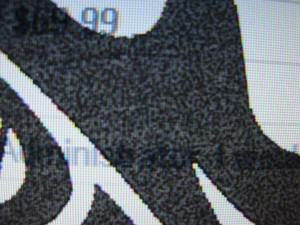
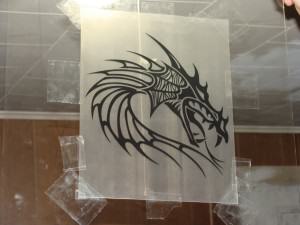
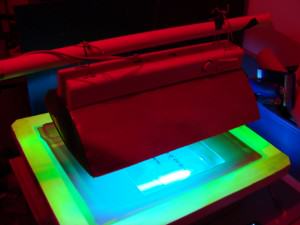
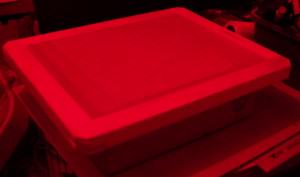
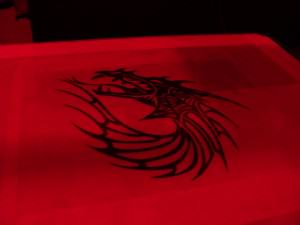
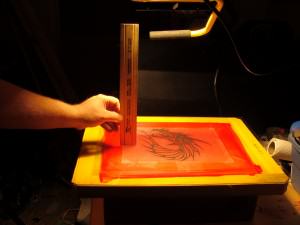
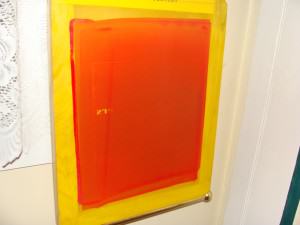
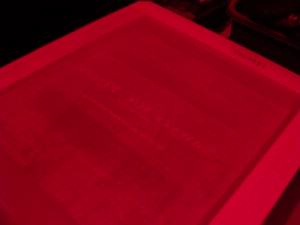
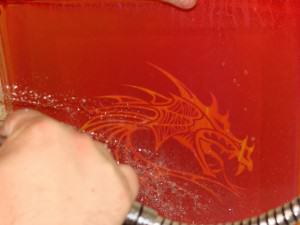
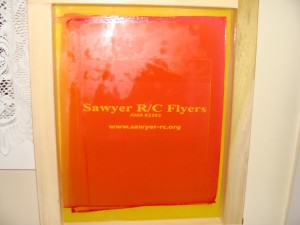
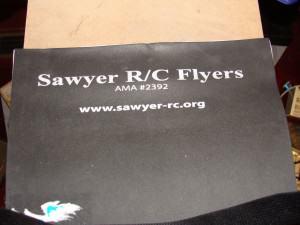
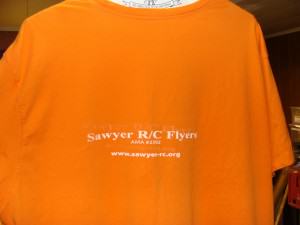

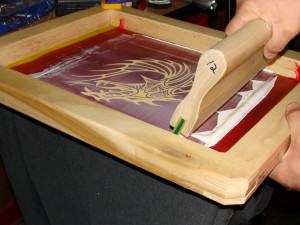
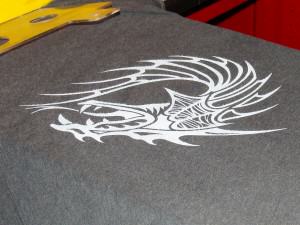

6 responses to Learning How to Silk Screen
Great details and visuals. Very helpful!
how to make offset printing inks
Loved your can do attitude really inspiring!
Okay I will look again. You are up late. Wow how do you do that and work son. Okay going here now. : _)
Yeah, the reason I’m usually involved in so much stuff is that I need to learn one thing to learn something else. It works out pretty good though, learning new stuff is one of the few things that keeps me going and as we know we gotta keep pushing forward and keep learning. 🙂
Hi Jon,
Followed your link from your FB posting. Real interesting. Funny how one project leads to another. But then I guess you were looking for another hobby anyway weren’t you. 🙂
Leave a reply to Learning How to Silk Screen